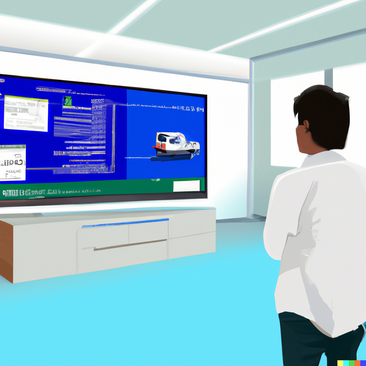Project Goals
The Fleet Management System Development project aimed to create a robust software solution to improve operational efficiency, enhance driver safety, reduce operational costs, and provide centralized management capabilities for large vehicle fleets. The primary objectives were to design and implement a system that not only monitors the fleet but also empowers managers with insights and tools to manage the fleet effectively.
Functional Capabilities
- Real-Time Vehicle Tracking: Developed features to track the location of any vehicle within the fleet at any given time, providing fleet managers with actionable data. This was achieved using GPS integration and mapping capabilities to allow real-time visualization of vehicle positions.
- Fleet Management and Analytics: Implemented modules for monitoring key metrics such as distance traveled, fuel consumption, and efficiency verification. These metrics help fleet managers assess vehicle utilization and detect inefficiencies.
- Fuel Management: Developed a fuel management subsystem that records refueling events, detects fuel leaks, and provides immediate alerts to fleet managers. The system also generates detailed reports on fuel consumption, highlighting inefficiencies and potential areas for cost savings.
- Driver Safety Management: Integrated data analysis tools to evaluate driver behavior. The system collects data on lane changes, speeding, acceleration/deceleration, and cornering behavior. These inputs are analyzed to generate driver safety scores, which are used to identify training needs and improve overall safety.
- Driving Quality Reports: Designed and implemented a set of customizable reports on driving quality, enabling fleet managers to assess each driver’s performance. Metrics such as excessive speed, abrupt maneuvers, and adherence to traffic rules are tracked, and reports are generated weekly or monthly.
- Performance Metrics Calculation: Developed algorithms for the automatic calculation of safety and quality metrics for each driver. Weekly performance reports are generated for both drivers and fleet managers, allowing them to track progress and take corrective actions if necessary.
- Maintenance and Issue Tracking: The system features tools for managing vehicle maintenance schedules, alerting managers to upcoming maintenance needs based on mileage, hours of use, or specific diagnostics. Early detection of issues helps minimize downtime and extend vehicle lifespan.
Solution Concept
The solution involves a combination of hardware installed in vehicles and a sophisticated software platform for fleet managers. The hardware components include GPS modules, fuel level sensors, speedometers, and accelerometers. These sensors collect data from the vehicle in real-time and transmit it to the software system for further processing. The software platform is a web-based solution with a user-friendly interface, providing fleet managers with a dashboard that offers real-time insights and alerts.
The system’s architecture was developed using a microservices approach to ensure scalability, reliability, and maintainability. Each major function (tracking, fuel management, driver safety analysis, etc.) is managed by its own service, which allows independent development, deployment, and scaling. This approach ensures that the system can handle large vehicle numbers and high-frequency data inputs with ease.
The software integrates with external data sources such as weather information and traffic data to provide contextual insights to fleet managers. For example, weather conditions are used to adjust safety recommendations and assess driving behavior under different conditions.
Results
- Improved Safety: The implementation of driver behavior monitoring and safety management led to a 3.5-fold reduction in accidents, including those with fatalities. Fleet managers received actionable insights that helped train drivers and correct dangerous behaviors.
- Fuel Efficiency: The system’s fuel management capabilities led to the elimination of almost all cases of fuel leakage. Fuel consumption was optimized, contributing to significant cost savings across the fleet.
- Operational Efficiency: Enhanced compliance with speed limits, optimized routes, and streamlined maintenance scheduling resulted in improved efficiency of fleet operations. The centralized monitoring and management capabilities helped reduce administrative overhead and improved decision-making.
Technologies and Architecture
- Microservices Architecture: The solution was built using a microservices architecture to ensure scalability and reliability. Each service could be independently scaled to handle specific functions, providing flexibility and robustness.
- Core Development Technologies:
- C# and .NET: Used for the core application development, ensuring compatibility and high performance.
- WCF (Windows Communication Foundation) and WPF (Windows Presentation Foundation): Used for the communication layer and user interface development, providing a robust framework for data exchange and presentation.
- Cassandra and MSSQL: Employed for data storage, with Cassandra handling high-volume, time-series data such as location and fuel readings, and MSSQL used for OLAP processing and report generation.
- Scrum, Kanban, and WaterScrumFall: Different development methodologies were employed to manage various aspects of the project effectively. Scrum was used for incremental feature development, Kanban for bug fixes and maintenance, and WaterScrumFall for combining agile practices with predefined stages of project delivery.
- TFS (Team Foundation Server): Used for source control, collaboration, and version management, facilitating team communication and accountability.
- Test-Driven Development (TDD): A test-driven approach was adopted to ensure the software was reliable and free from critical bugs. Automated tests were created for each module to ensure continuous integration and delivery.
- Containerization: Docker was used to containerize microservices, simplifying deployment and enhancing the system's scalability.
User Cases
- Fleet Managers: The primary users of the system are fleet managers who require real-time data to make informed decisions regarding vehicle allocation, route planning, and maintenance scheduling.
- Fleet managers can monitor individual vehicle performance, track key metrics, and detect maintenance needs early.
- Managers receive alerts on fuel anomalies or safety concerns, allowing them to take proactive measures to prevent incidents.
- Reports generated by the system help in reviewing driver performance, ensuring compliance with safety standards, and managing overall fleet efficiency.
- Drivers: Drivers receive performance feedback based on the collected data, which helps them improve their driving habits. Weekly safety scores encourage a safer driving culture, while maintenance alerts ensure that vehicles remain in good condition.
Integration and Development Process
- Integration: The system was built with a plugin-based architecture, allowing seamless integration with external systems. This includes integration with ERP systems for financial tracking, telematics systems for additional data sources, and customer relationship management systems for improved fleet service coordination.
- Development Methodology: A combination of Scrum, Kanban, and WaterScrumFall was used to cater to different project needs. Scrum ensured rapid feature iteration, Kanban handled ongoing maintenance, and WaterScrumFall supported the structured aspects of development.
- Testing: Performance and stress testing were conducted to validate the system's behavior under heavy loads, simulating large fleet operations in real-world conditions. The testing phase involved collecting feedback from pilot users, adjusting system features, and fine-tuning scalability and responsiveness.
Client Benefits
- Operational Cost Reduction: The implementation of the system led to a significant reduction in operational costs, as better management led to fuel savings, less downtime, and optimized use of the fleet.
- Enhanced Safety Compliance: Driver monitoring and feedback tools helped ensure drivers complied with safety standards, significantly reducing the number of incidents.
- Streamlined Fleet Management: The centralized platform allowed managers to access real-time data and reports from one place, reducing administrative work and enabling better decision-making.
- Customizability and Scalability: Due to the microservices and plugin-based architecture, the system can be easily customized to meet specific client needs and scaled to accommodate fleet expansion.




